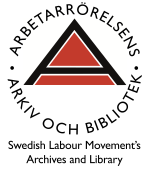This is a brief information for those who are not familiar with the Swedish archival systems or the collections of Swedish Labour Movement’s Archives and Library.
Archival repositories or institutions as Swedish Labour Movement’s Archives and Library create inventories, registers, indexes or archival description in order to describe the collections. These finding aids, gives the researcher an overview of a collection/archives content, as well as the conditions under which it may be accessed, it’s provenance etc. The chosen model for the finding aids of archival materials at our institution is the general archive schedule, described below.
General Archive Schedule
A. Protokoll (Protocols)
B. Utgående handlingar (Outgoing documents)
C. Diarier (Diaries)
D. Register och liggare (Registers and ledgers)
E. Inkomna handlingar (Incoming documents)
F. Handlingar ordnade efter ämne (Documents according to subject)
G. Räkenskaper (Accounts)
H. Statistik (Statistics)
J. Ritningar och Kartor (Drawings and maps)
K. Fotografier (Photographies)
L. Trycksaker (Prints)
Ö. Övriga handlingar (Other documents)
In Sweden the sub-divisons of the main groups are represented by numbers, such as:
A1:1 Early protocol, volume 1
A2:2 Board meeting protocol, volume 2
Archival descriptions for personal archives
According to the personal archive schedule of Dr. Martin Grass, Swedish Labour Movement’s Archives and Library is using the following mode. Here roughly described, as all organisation of archives depend on the material at hand and the individual archivist.
1. Personliga handlingar (personal documents)
2. Egna verk (personal publications)
3. Brevsamling (correspondence)
4. Handlingar rörande personens verksamhet (documents relating to the person’s own activities)
5. Samlingar (collections)
Library collections
The library collections are divided into three main subgroups which are also described as a location in the library catalogue.
- the reference literature which is accessible by our reading room and research desk,
- the collections which are intended for in-house loans only and
- the literature which is intended for regular (home) loans.
The majority of the collections are stored in storage facilities alongside the archival material.
“In September 2012, Sweden’s National Librarian Gunilla Herdenborg made a decision on the Swedish transition to RDA. Since April 1, 2014, a project has been in progress at the National Library, with the task of preparing for the transition.
The project group at the National Library of Sweden. In the back row from the left: Bibliographic Expert Olle Johansson, Librarian Pär Öberg and Bibliographic Authority Expert Eva Abrahamsson. In the front row from the left: Map and Image Expert Solveig von Essen and Project Manager Katarina Synnermark. Photo: Annika Hjerpe
KRS, the Swedish cataloguing rules, are a translation and adaptation of AACR2 (the Anglo-American Cataloguing Rules, 2nd ed). AACR2 has circulated widely around the world, and linking our rules to them has facilitated international collaboration and postal exchange. Now that AACR2 has been replaced by RDS and is no longer being updated, a transition to RDA is necessary.”
I you have questions regarding the collections, please send an email to forskarexpedition[a]arbark.se.
